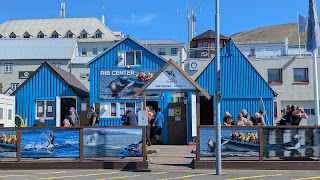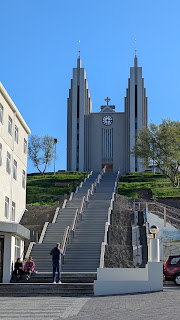 1. The landscape of Iceland is sculpted largely by glacial, volcanic and geothermal activity. Therefore, lava fields, craters, waterfalls, rivers, lakes, gorges, canyons and basalt cliffs predominate the tourist experience.
1. The landscape of Iceland is sculpted largely by glacial, volcanic and geothermal activity. Therefore, lava fields, craters, waterfalls, rivers, lakes, gorges, canyons and basalt cliffs predominate the tourist experience.
2. One of the first things a tourist is told on arrival in Iceland is that tap water everywhere in the country is safe to drink. Hotels and guesthouses have this laminated and stuck on walls for attention of tourists.
3. However, the hot water is smelly due to its sulphur content. It does get some getting used to. Perhaps due to this, soap does not foam as much as it does in soft water.4. Grocery stores and normal merchants' shops can sell only liquor with less than 2 percent alcohol. Regular alcohol is only sold in special liquor stores like Vinbudin, which are not open after 6 pm and are closed on weekends.
5. The three main vendors of fuel are Ob, N1 and Orkan. Prices are more or less the same when you factor in discounts offered by the various fuel companies to its regular customers. The price of 95 octane is about INR 215 per litre and diesel is a bit more expensive.6. Fuel stations are largely automated. Automated fuel stations normally take pre-authorization on your card for ISK 30,000, which is roughly USD 230. For someone like me, who is not a acquainted with the process, it is alarming the first time over. To be sure, the company charges only for the amount of fuel pumped.
7. Smoking did not seem to be popular among the Icelandic population. This certainly helps in keeping the environment healthy.
8. The people are, by and large, peace loving and engaging. They are calm and seldom argumentative.9. The Icelandic population is sparse, just 4 million in a vast country where nearly 40 percent live in urban conglomerations like Reykjavik. As against this, the tourist inflow is more than 10 million a year.
10. The crime rate is quite low in the country. In fact, it is said that no car theft has been reported in the country. I gathered that pickpocketing and other tourist related petty crimes are reported at times.
11. The food is expensive and eating in restaurants can burn a hole in your pocket. I economized on this front by carrying muesli, maggi noodles, pasta, etc. If you don't want to do this, one can shop in grocery stores like Bonus and Netto and cook in the accommodation, if it has a kitchen.
12. Entrance to attractions is expensive too. Interestingly, most of the touristy attractions charge a parking fee, depending on the size of the vehicle, and that doubles up as the entrance fee too.13. Parking fee is normally paid using an app called Parka. Through this app entrance fee can be paid, booking of attractions can be made, payment of toll charge can be organised, Parking fee is divided into four zones, based on the primacy of the location; P1 parking is most expensive while P4 is the least. In a city like Reykjavik, it is virtually impossible to find free parking. However, parking is free between 9 pm and 9 am on weekdays.
14. Public toilets are clean, and they are provided with adequate toilet paper, soap and water. Users ensure that the public facilities are used responsibly.
15. In general, a vacation in Iceland is a costly proposition as compared to even other places in Europe, not to talk of a South Asian vacation. However, self-cooking and staying in guesthouses and hostels can reduce the impact on solo travelers and young couples. I was amazed by the abundance of guesthouses in various parts of Iceland that cater exclusively to tourists.16. Driving in Iceland is pretty much hassle-free if one follows road rules. The roads are generally single carriageways, decently maintained and exceptionally well sign posted. Speed restrictions are expected to be followed without exception. Traffic cameras identify the deviant, and fines are so steep that people generally follow the prescribed speeds that range between 50 and 90 kph. Another matter strictly enforced is the use of reserved parking slots. Violations are taken seriously and dealt with accordingly.
17. The churches in Iceland are simple and small; nothing fancy or ornate. They are normally Lutheran churches, and each village and small community has one.18. The basic infrastructure in Iceland is less about grandeur and more about functionality. Whether it is road infrastructure, malls or residential buildings, functionality predominates.
19. In most public places I did not find garbage bins. Nor did I find waste strewn about. I looked for at least a piece of paper or a plastic jacket. What has to be kept in mind is that they are all places that are tourist oriented. Moral of the story is that the culture of cleanliness and public hygiene practiced by the local citizenry rubs off on the visitors too.
20. I did not see any overarching presence of policemen to enforce traffic rules and societal norms. Their quiet efficiency must be appreciated. Exemplary punishments and monetary penalties keep almost all in line.21. By and large, Icelandic people are friendly and helpful. They do not jump in to help if they find you struggling, but they will wholeheartedly pitch in if you seek their assistance.
22. Pedestrian crossings are sacrosanct, and pedestrian is King. She owns the road. Similarly, villages are also protected by enforcement of speed limits through them, mostly 50 kph and often times 30 kph too.
23. People of Iceland respect nature and their environment. Any action by the authorities that are deemed to go against preservation of nature is vetoed by citizens and even the government cannot overrule them. Thus, in recent times there have been calls to curtail tourism, as this industry is seen to be in conflict with preservation of nature and the environment. Well known tourist sites are shut down for years to guard them against vandalism and damage owing to uncontrolled tourist arrivals.24. Icelandic people are brought up on a diet of elves and trolls, it is part and parcel of their folklore. While elves are naughty, mischievous and invisible, trolls live in caves and are thought to be half human, half giant.25. Icelanders' sagas are a distinct genre of Old Icelandic literature, often considered to be a precursor to the novel. Recurring themes in the sagas include feuds, family loyalty, revenge, and the consequences of social and political upheaval.
26. During the summer months of June and July daylight hours stretch to about 22 hours with the rest reserved for twilight. During the peak winter months of December and January daylight hours are restricted to about three hours. However, wind and rain lead to unpredictable weather conditions.27. Renewable energy sources contribute almost to be entire requirements of power supply in Iceland. Hydroelectric generation contributes 70% while geothermal sources contribute the balance 30%.



































































